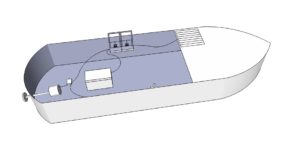Electric boating – electricity-based water transport is the future. With the help of Elektrisch Varen Foundation Amsterdam can look forward to a sustainable and innovative infrastructure. There is no better place worldwide to begin with this transition.
Thanks to the low drag of water as well as the large cargo capacity of boats, the potential of our infrastructure is formidable. Attempts at establishing sustainable infrastructures often fail due to short-term thinking on the market or due to simplistic introduction of compensatory duties. Recent developments in the area of battery technology for cars and mobile devices promise a much more cost saving implementation for this project. This being said, the wholesale transition from combustion engines to electrical motors will only be made possible by the necessary energy supply. With this goal in mind Elektrisch Varen Foundation aims to revive an old concept: exchangeable batteries. This both economically and ecologically functional idea has already been implemented for cars. The use of exchangeable batteries for a large public is however hampered by the large size and heavy weight of these batteries. In East-Asia and in Israel currently comparable systems can be found for electric scooters. For pleasure boats the batteries have now reached a small enough weight to enable a manual battery swap. Today boaters can exchange a battery themselves. Thanks to this development the battery swap has thus become technically and economically feasible.
Elektrisch Varen Foundation has devised with two ideas for battery charge- and switch-stations.
The first model called ‘Febo’ is a floating pontoon whereon lockerboxes stand, stuffed with fully charged battery-packs.

The second model called ‘kiss&go’ is a floating battery container where boats can moore easily. This battery charge- and switch station only takes little space and it is suitable for boats with a low gunwale especially.

The batteries available in the charge- and swap-stations will weigh around 7 to 10 kg’s. With lithium technology such battery pack is good for 1 to 3 hours of electric propulsion joy. Of course this estimate is interdependent with (the weight of) the boat and the speed it is propulsed with. In any case there will always be suffficient energy available in the battery to reach the next battery charge- and swap-station. In a boat also several batteries can be coupled to increase crusing duration or the range of heavy or fast boats. It will be possible to drive electric motors of 12, 24, 36 or 48 volts. That may be e-outboard motors, e-motors on propeller driveshafts, e-motors on saildrives, e-pod motors, all sorts of e-jet drives or even e-motors coupled to paddle wheels.
The connecting of the battery goes by a docking station with sliding contacts attached to the boat. The docking station also regulates the unlocking of a full battery by a transmitter if a depleted battery has been handed in. In fact the boater checks in with his boat. Next to this, the docking station also locks the battery on the boat while cruising.

It is mandatory that the boat always carries its own battery. When the boater starts crusing she/he must be able to reach the battery charge- and swap-station and at the end of the tour she/he must be able to reach his mooring spot again with this battery. This battery will be recharged slowly by the swapable batteries while crusing, and sets of solar panels are available to keep this battery in good condition when moored. This will be particularly handy if the private battery is a heavy (lead) battery, preferred to leave on the boat when moored. The possibility remains to choose a small battery with a high capacity which is light enough to carry home for a recharge.
Maybe this all sounds complicated to you but in fact it is much less complicated as you may think. Is is much easier than sailing e.g. Once you get accomadated to it the whole network is yours. Crusing times and crusing ranges are unlimited and with a rough calculation you could cruise electrically without limitations for an annual membership of 50 to 200 Euro.
